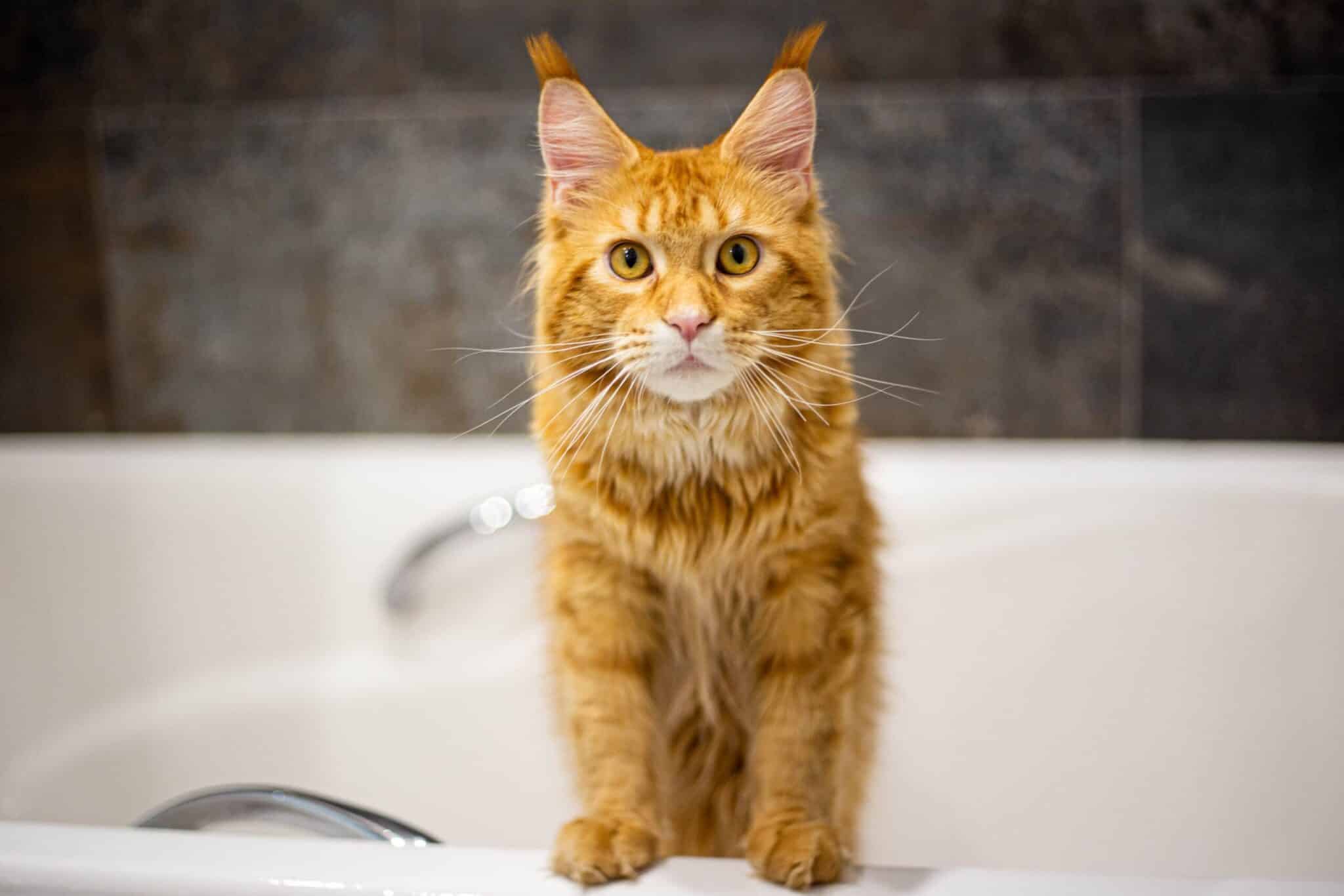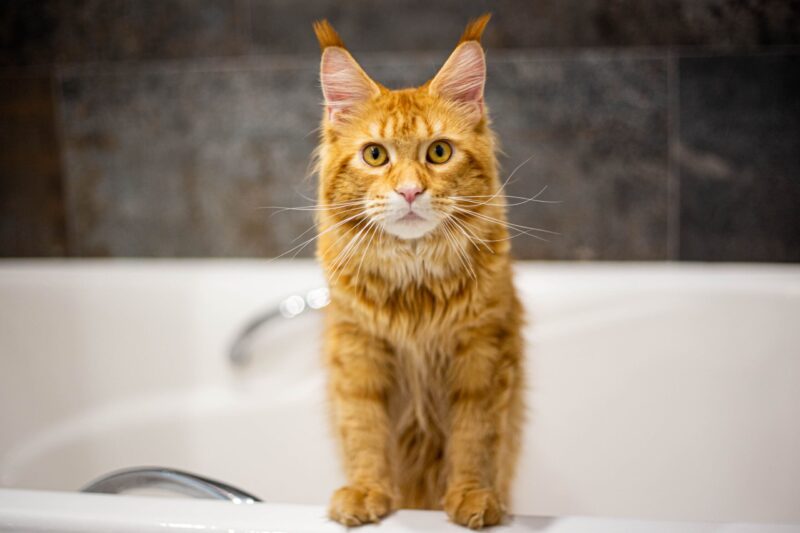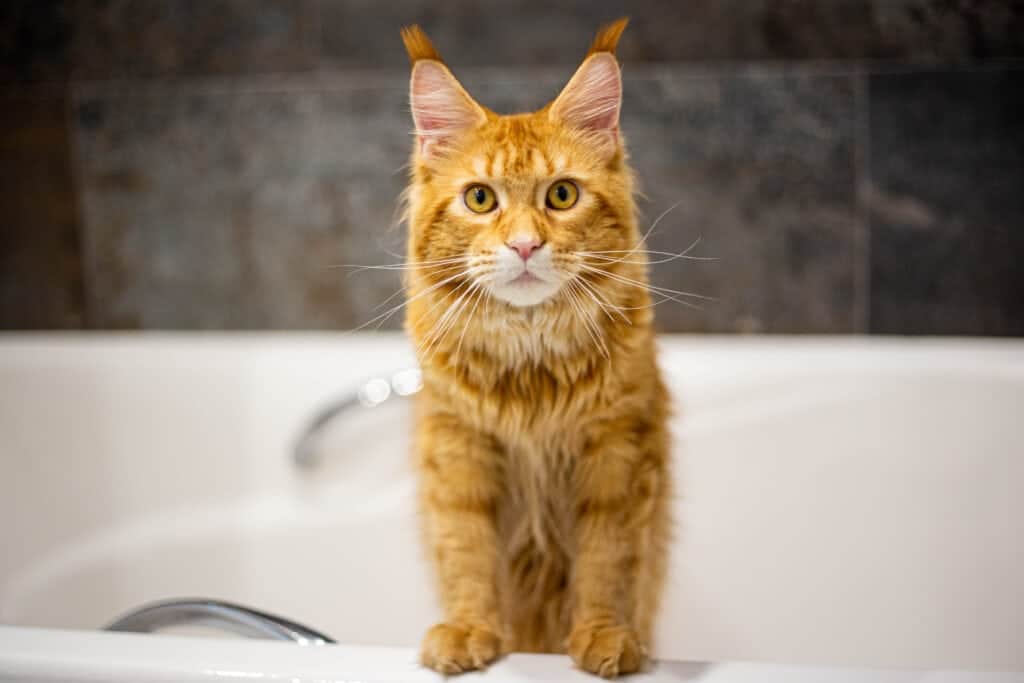
Whether you are in search of something to help reduce shedding due to their higher-than-average grooming needs, provide relief for itchy, irritated skin, or just something to keep them fresh and clean, we’ve got you covered.
After looking at reviews for the best products on the market this year, we came up with a list of the best shampoos for Maine Coon cats.

A Quick Comparison of Our Favorites of 2024
| Image | Product | Details | ||
|---|---|---|---|---|
| Best Overall |

|
Hepper Colloidal Oatmeal Cat Shampoo |
|
CHECK PRICE |
| Budget Buy |

|
Frisco Shed Control Shampoo |
|
CHECK PRICE |

|
Earthbath Oatmeal & Aloe Shampoo |
|
CHECK PRICE | |

|
TropiClean Hypo-Allergenic Shampoo |
|
CHECK PRICE | |
|
|
MiconaHex+Triz Shampoo |
|
CHECK PRICE |
The 8 Best Shampoos for Maine Coon Cats
1. Hepper Colloidal Oatmeal Pet Shampoo — Best Overall
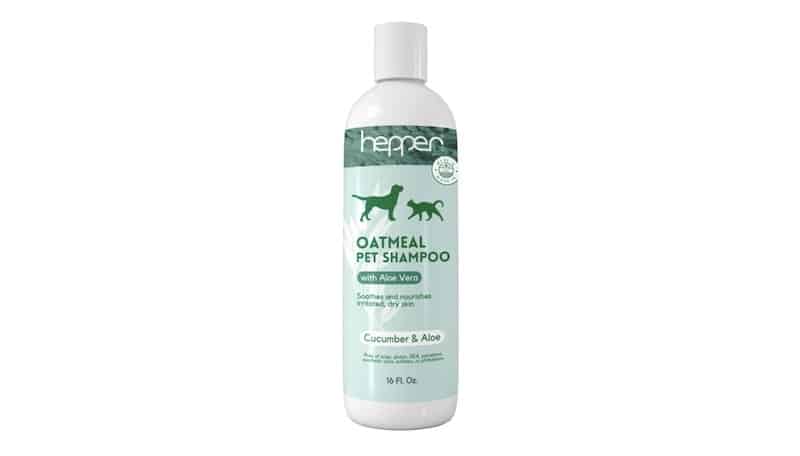
| Quantity: | 16 fluid ounces |
| Grooming Feature: | Reduce shedding, moisturize, cleanse |
| Life Stage: | 6 weeks or older |
| Ingredients: | Water, sodium C14-16 olefin sulfonate, sodium chloride, cocamidopropyl betaine, glycerin, cocamidopropyl hydroxysultaine, sodium gluconate, fragrance, oatmeal extract, citric acid, aloe barbadensis extract, colloidal oatmeal |
Hepper’s Colloidal Oatmeal Pet Shampoo is currently our favorite cat shampoo for Maine Coon cats. This pH-balanced, all-natural shampoo is gentle on your cat’s skin and coat. Soothing ingredients like aloe vera and oatmeal help to moisturize your Maine Coon’s skin while gently cleaning and reducing shedding.
Anyone with a Maine Coon knows that they have quite a bit of fur, and we found that this shampoo can handle it! It has a nice cucumber and aloe scent that leaves your cat smelling fresh for days. Plus, it’s made in the USA.
Overall, we think this is the best cat shampoo for Maine Coon cats that you can find this year.
At Catster, we’ve admired Hepper for many years and decided to take a controlling ownership interest, so that we could benefit from the outstanding designs of this cool cat company!
- pH-balanced all-natural formula
- Gentle cleansing and moisturizing
- Great for Maine Coon cat fur
- Made in the USA
- Soothing ingredients reduce shedding
- Not fragrance-free
2. Frisco Shed Control Shampoo with Aloe – Budget Buy

| Quantity: | 20 fluid ounces, 1 gallon |
| Grooming Feature: | Reduce shedding, cleanse |
| Life Stage: | Adult |
| Ingredients: | Purified water, coconut & plant-derived cleansers, oat protein, conditioner, humectant, aloe vera juice, fragrance, salt, jojoba oil, EDTA, vitamin E, pro-vitamin B5, preservative, vitamins A/D |
If you’re on the market for a budget shampoo for your Maine Coon, look no further. We chose the Frisco Shed Control Shampoo with Aloe. This shampoo comes in 20 fluid ounces or a 1-gallon size and can even be bought with the Frisco Shed Control Conditioner if you choose.
This shampoo is inexpensive considering the quantity and is specially made for heavy shedders, like the Maine Coon. Not only does it assist with shedding and management of the undercoat, but it also cleanses well and is made with plant-derived ingredients to be gentle on your cat’s skin and leave the coat nourished and strong.
This shampoo is made in the United States and contains no parabens or dyes. The not-so-great reviews were mainly owners not enjoying the smell. There was a complaint that they felt their pet shed worse after use.
- Contains no parabens or dyes
- Helps reduce shedding and manage undercoat
- Oat protein, jojoba oil, and pro-vitamin B5 help nourish and strengthen the cat’s coat
- Some owners did not enjoy the smell
- Some owners complained of excess shedding after use
3. Earthbath Oatmeal & Aloe Fragrance-Free Shampoo

| Quantity: | 16 fluid ounces |
| Grooming Feature: | For sensitive skin and allergies, cleanse, moisturize |
| Life Stage: | 6 weeks or older |
| Ingredients: | Purified water, colloidal oatmeal (3%), renewable plant-derived & coconut-based cleansers, aloe vera, vitamins A, B, D, & E, glycerin, allantoin, natural preservative |
Our third choice for the best shampoo for use on Maine Coon Cats is the Earthbath Oatmeal & Aloe Fragrance-Free Shampoo. Not only is it fragrance-free, but soap-free as well. It is formulated to provide relief for cats or dogs with dry, itchy, and sensitive skin.
This shampoo does great at cleaning, deodorizing, and keeping the skin well-nourished without causing any irritation or washing off topical flea applications. We opted to have the Earthbath Oatmeal and Aloe Fragrance-Free Shampoo listed as our premium choice for its lack of bad reviews.
While it may not be geared toward shedding like some of the other Maine Coon shampoo options, it does a great job for even the most sensitive cats.
- 100% biodegradable, paraben and phosphate-free
- Free of fragrance and soap
- Cleansing and moisturizes while relieving itchy, dry skin
- Slightly higher cost
- Not designed to reduce shedding
4. TropiClean Hypo-Allergenic Coconut Shampoo

| Quantity: | 20 fluid ounces |
| Grooming Feature: | Hypoallergenic, cleansing |
| Life Stage: | Any |
| Ingredients: | Purified water, mild coconut cleanser, Avena sativa oatmeal, vitamin E, aloe extract |
The best choice of shampoo for your Maine Coon kitten would be the TropiClean Hypo-Allergenic Gentle Coconut Shampoo. This shampoo is designed to be gentle enough for use on kittens. It’s not limited to the little ones though, and it is also a great choice for any cats that have sensitive skin or just need a nourishing bath.
This shampoo is made from natural ingredients, is pH balanced, and contains no soap, dyes, or parabens. It lathers up nicely, degreases, cleans, and moisturizes both the fur and the skin. Not only does it leave their coat soft but smelling great as well.
- All-natural ingredients and pH balanced
- Moisturizes skin and coat
- Gentle enough for kittens
- Some bottles came damaged
- Some owners didn’t enjoy the coconut smell
5. MiconaHex+Triz Shampoo for Dogs & Cats

| Quantity: | 16 fluid ounces |
| Grooming Feature: | Medicated, anti-fungal, antiseptic |
| Life Stage: | Weighing 1 pound or more |
| Ingredients: | (Active) 2% miconazole nitrate USP, 2% chlorhexidine gluconate USP, USP tris-EDTA (Inactive) water, lauramine oxide, lactic acid, cocamidopropyl betaine, decyl glucoside, polyacrylate-1 crosspolymer, ceramide complex, lavender oil, lemongrass oil, methylchloroisothiazolinone, methylisothiazolinone |
Our choice for the top medicated shampoo for Maine Coon’s is the MiconaHex+Triz Shampoo for Dogs & Cats. This shampoo has been formulated for animals with skin conditions that are responsive to miconazole and/or chlorhexidine. If your cat struggles with moderate to severe fungal or bacterial infections, this is a great go-to choice for a medicated shampoo.
This shampoo can fight yeast and other fungal infections, bacterial infections, ringworm, and even dandruff. The formula is paraben-free and contains ceramides to help moisture and restore the skin.
The biggest downfall for this shampoo is that it’s not meant for everyday use and should only be used if you need a medicated shampoo for your cat. Some owners were advising it was ineffective for their pet. When trying to treat any skin conditions, it’s always best to consult your veterinarian first.
- Antimicrobial, antifungal, and moisturizing
- Helps pets with skin allergies
- Only for medicated use
- Not effective for some
6. FURminator Ultra Premium Deshedding Shampoo
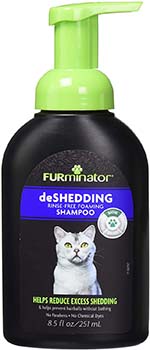
| Quantity: | 5 fluid ounces |
| Grooming Feature: | Reduce shedding, prevent hairballs, cleanse |
| Life Stage: | 6 weeks or older |
| Ingredients: | Water, mild surfactants, hydrolyzed wheat and oat proteins, omega-3 and 6 fatty acids from cranberry, sunflower and safflower seed oils, kava, calendula, chamomile, mallow, aloe vera, and papaya extracts, vitamin E, fragrance, preservatives, and salt |
Another great shampoo for a Maine Coon cat is the FURminator Ultra Premium Deshedding Shampoo. This is a rinse-free foaming shampoo that is great to have on hand for the long-haired Maine Coon for a bath in between baths.
As the name suggests, it helps to reduce excess shedding and in turn, prevent hairballs without having to give them a full bath. This foaming spray contains no parabens or chemical dyes and is enriched with hydrolyzed plant proteins and omega fatty acids.
We recommend this above all due to the high maintenance of the Maine Coon’s coat and the excessive shedding they are prone to. Having this on hand to give a quick waterless bath will help you eliminate that excess hair and leave your cat clean and fresh. This does not eliminate the need for semi-regular rinse baths, but you can use it along with some other grooming tools as well. FURminator has a whole line of deshedding products to choose from.
Overall, this is a very well-reviewed product among cat owners. The biggest downfalls were that some pets with sensitive skin did have a reaction and others felt it may have thinned the hair a bit too much. Some owners complained of the smell, but that is typical with any bathing product. We would recommend doing a small spot test on your cat to ensure it does not irritate them.
- Reduces shedding and hairballs
- Free of parabens and chemical dyes
- Contains hydrolyzed plant proteins and omega fatty acids
- Cruelty-free practices
- Irritated some pets with sensitive skin
- Strong smell
- Some owners felt it thinned their pet’s hair
7. John Paul Pet Sensitive Skin Formula Shampoo

| Quantity: | 16 fluid ounces |
| Grooming Feature: | Moisture for sensitive skin, cleanse |
| Life Stage: | Adult |
| Ingredients: | Water, sodium laureth sulfate, cocamide mipa, cocamidopropyl betaine, sodium chloride, aloe barbadensis leaf juice, chamomilla recutita (matricaria) flower extract, prunus amygdalus dulcis (sweet almond) oil, hydrolyzed oat protein, butylene glycol, citric acid, phenoxyethanol, magnesium chloride, magnesium nitrate, methylchloroisothiazolinone, methylisothiazolinone, fragrance, yellow 5 |
John Paul Pet Sensitive Skin Formula Shampoo is made from the makers of the well-known Paul Mitchell hair care products. This shampoo is made for those with dry, flaky, and sensitive skin and comes specially formulated with a blend of aloe, chamomile, and hydrolyzed oat protein to nourish, moisturize, and cleanse.
The sweet almond oil leaves a great fragrance and helps condition the coat. This product is made in the USA and guaranteed cruelty-free. This shampoo is not only great for cats but dogs and horses as well.
There is a longer list of ingredients for this shampoo choice, and it does include dyes and perfumes. The biggest complaint from reviewers was that the fragrance didn’t last long enough. It may not help with de-shedding like some of the other options which is a very convenient feature for Maine Coon cats.
- Cleanses and moisturizes
- Great for sensitive skin
- Cruelty-free practices
- The smell doesn’t last long
- Not geared toward deshedding
8. Vet’s Best Waterless Cat Bath

| Quantity: | 4 fluid ounces |
| Grooming Feature: | Waterless, cleansing |
| Life Stage: | 12 weeks or older |
| Ingredients: | Neem oil, micronized oatmeal, vitamin E, aloe vera, panthenol (vitamin B-5), allantoin, and natural fragrance |
The Vet’s Best Waterless Cat Bath is another waterless shampoo option that is a great choice for a quick clean in-between full rinse baths for your Main Coon. Best for use on cats 12 weeks or older, this formula is derived from natural ingredients and is free of parabens, dyes, and sulfates.
Vet’s Best Waterless Cat Bath does not replace the need for full rinse baths but makes for a great go-to option for freshening up in between them. Unfortunately, it’s not meant to help with deshedding, as most Maine Coon owners prefer. Some reviewers complain about the strong scent but others find it pleasant.
- Cleansing and refreshing between full baths
- Soothes dry skin
- Free of paraben, dyes, and sulfates
- Not geared for deshedding
- Some owners didn’t enjoy the smell
Buyer’s Guide: Selecting The Best Shampoo for Maine Coons
When deciding on the best shampoo option for your Maine Coon or any other cat, you do have some things to consider before finalizing your decision. Below, we will go over some of the things you should keep in mind while shopping for the best shampoo.
Cost/Quantity
Since these two go hand in hand, we’ve combined price and quantity. When making any purchase, you will need to consider the cost of the product in reference to your budget as well as the cost compared to the quantity you are getting for that price. Some shampoos may look like they are a great deal, but it turns out you only get a few ounces of shampoo in the bottle. We have included the quantity of each product on the list to help you get an idea of how much shampoo you’ll get with each choice.
Ingredients
The ingredients in shampoo are a very important consideration and it’s highly recommended that you have a look at what is in the shampoo before purchasing. Some shampoos can contain harmful ingredients that could cause mild to severe skin irritation for some cats. If you know your cat has sensitive skin or is prone to skin allergies, you’ll need to opt for sensitive formulas with safe, natural ingredients.
Shying away from shampoos that contain artificial dyes, parabens, sulfates, alcohol, and other chemicals is the safest option for your cat. There are many shampoos on the market today that are made with all-natural, plant-derived ingredients that are formulated without the harmful stuff.
Designed for Cats
You need to ensure the shampoo you purchase is designed for use on cats. You will notice that many shampoos are safe for both cats and dogs and that’s fine too. You never want to use human shampoo on your cat, it’s necessary to stick with products that manufacturers designed specifically for cats.
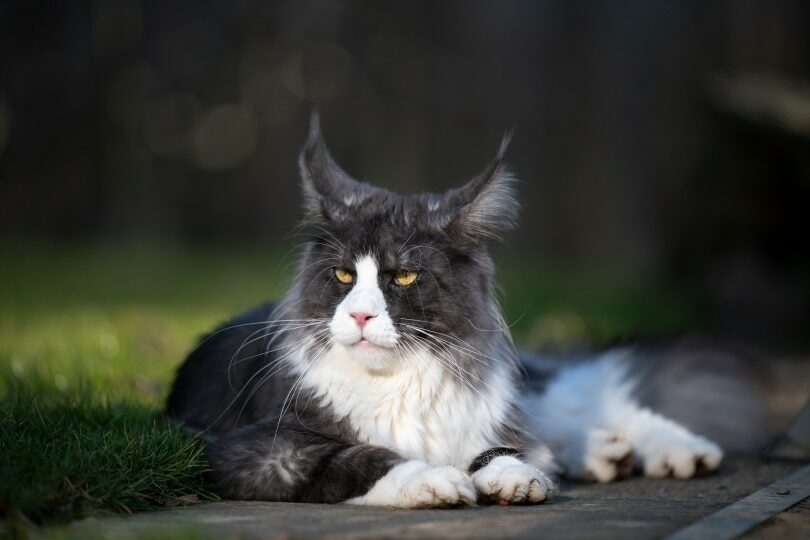
Purpose
A lot of Maine Coon owners will likely opt for deshedding shampoos since the Maine Coon is a long-haired, heavy shedder with high maintenance grooming needs. A lot of shampoos available serve multiple purposes such as cleansing, moisturizing, and deodorizing as well.
Cats with skin allergies or sensitivities should be bathed with shampoos that are hypo-allergenic and formulated for sensitive skin. You may even run into the need for medicated shampoo for antifungal, antiseptic, and anti-bacterial needs.
You’ll have to figure out what your needs are for your specific cat and decide which purposes are the most important to you.
Age Appropriate
Ensuring the shampoo you are purchasing is age-appropriate for your Maine Coon is something to keep in mind. This mainly goes for kitten owners since most shampoos are safe for adult cats. Make you look at the bottle to see the recommended age for use. A lot of shampoos are recommended for cats and kittens 6 to 12 weeks or older, some may even have weight requirements.
Other Grooming Products to Consider
If you want to prolong that dreamy just just-washed scent and prevent pesky tangles or tame out-of-control static, these two products by Hepper are gamer changers. Incorporating them into your grooming routine will ensure your cat's coat will remain silky smooth, their skin moisturized, and of course, best of all, smelling light and fresh. Hepper's Pet Conditioner is a great way of rehydrating your cat's skin and coat before taking them out of the bath. It may also make the drying process a little quicker and painful tangles a thing of the past. The Hepper Pet Cologne is a pet-safe deodorizer that you can spritz on a brush or on their coat directly. Work the cologne through fur for a just left-the-kitty-salon scent and smooth, static-free finish.

|
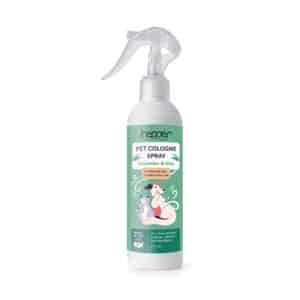
|
|
|---|---|---|
| Hepper Pet Conditioner | Hepper Pet Cologne | |
| Great for between washes |
Great for between washes :
|
Great for between washes :
|
| Reduces static |
Reduces static :
|
Reduces static :
|
| Long lasting scent |
Long lasting scent :
|
Long lasting scent :
|
| Smooths & prevents tangles |
Smooths & prevents tangles :
|
Smooths & prevents tangles :
|
| Does not require a rinse |
Does not require a rinse :
|
Does not require a rinse :
|
| Pet safe ingredients |
Pet safe ingredients :
|
Pet safe ingredients :
|
| Vet recommended |
Vet recommended :
|
Vet recommended :
|
| Hydrates coat & nourishes skin |
Hydrates coat & nourishes skin:
|
Hydrates coat & nourishes skin:
|
At Catster, we’ve admired Hepper for many years and decided to take a controlling ownership interest so that we could benefit from the outstanding designs of this cool cat company!
Benefits of Bathing Your Maine Coon
Reduce Shedding
It’s no secret that your Maine Coon has a lot of hair and an undercoat to go along with it. They are a bit high maintenance when it comes to grooming needs. Regular baths can help reduce excess shedding, manage the undercoat, and even prevent hairballs.
If you are looking for recommendations on the best cat brush, you should check out Hepper Cat Brush. You will hardly find different brush with so many pros - easy to clean, easy to use, durable and effective. Simply everything you need from a cat brush. Click here to order yours today.
At Catster, we’ve admired Hepper for many years and decided to take a controlling ownership interest so that we could benefit from the outstanding designs of this cool cat company!
Keep Them Clean
While they may be masters at grooming themselves and are well-known for being very clean animals, bathing them regularly can help keep their coats clean of dirt, dust, and anything else they get into. Bathing them regularly will keep their coats cleaner and prevent them from licking off any unwanted debris.
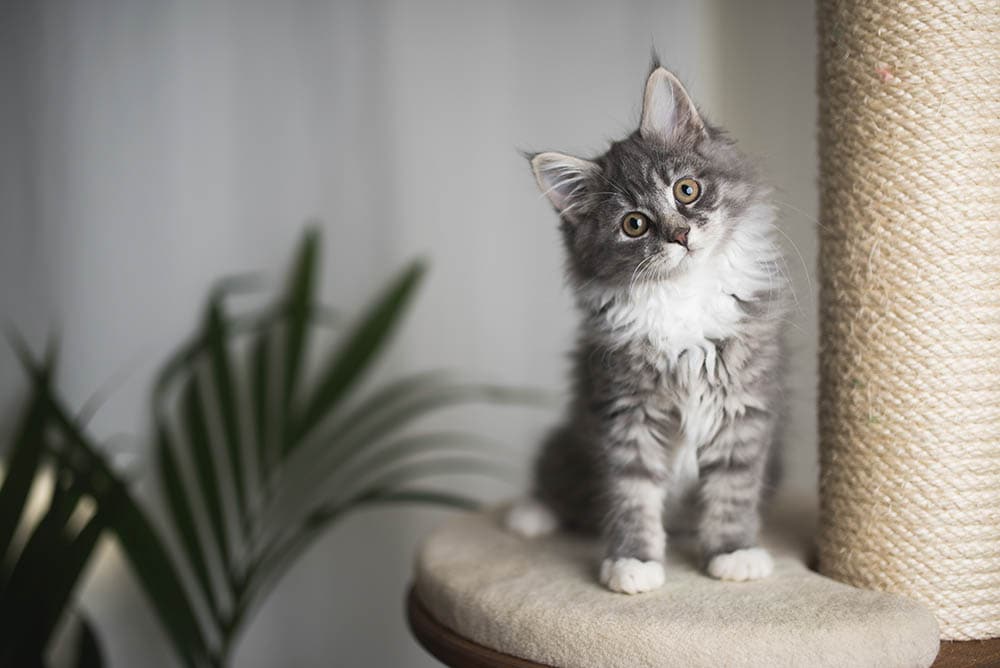
Maintain a Healthy Coat
Regular shampoo can help prevent the Maine Coon’s long coat from tangling and matting. You may even notice that after a while they can even begin to look a little greasy. A quick bath can solve that, and the right ingredients can leave their coat soft, shiny, healthy, and smelling great.
Provide Relief or Relaxation
Not all cats enjoy bath time, but if you introduce them to regular baths as kittens, they can even learn to enjoy them. It can provide a bit of relaxation and bonding with their owner, depending on the individual of course. Not only that but regular bathing can also help relieve cats with skin allergies and other skin conditions that leave them dry, itchy, and irritated. If you do have a cat that suffers from skin conditions, make sure to use an appropriate shampoo for the job.
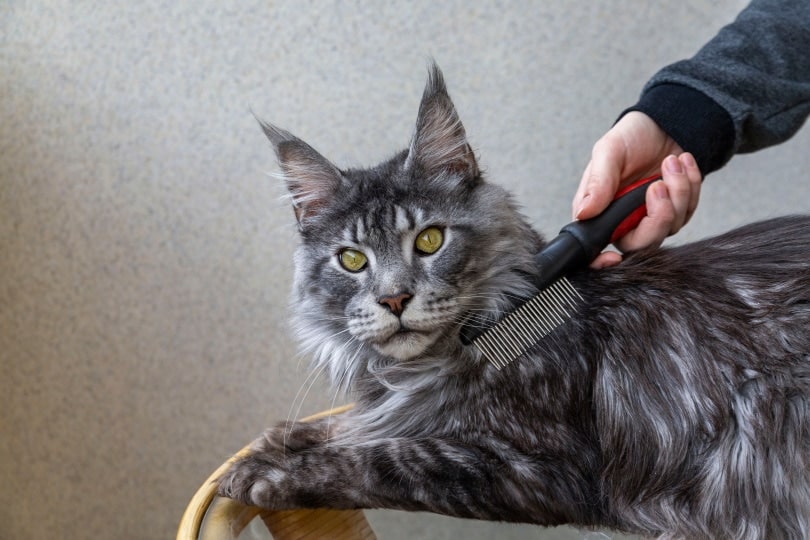
Conclusion
Hepper’s Colloidal Oatmeal Pet Shampoo has a pH-balanced, all-natural formula that gently cleanses your Maine Coon cat while moisturizing and reducing shedding. It has a pleasant, light scent and reduces irritation and itchiness.
Frisco Shed Control Shampoo with Aloe comes in different size options, is free of parabens, and is derived from plant-based ingredients.
Now that you have more information on the things to consider before your purchase, the benefits of bathing your Maine Coon, and have a list of some of the best-reviewed products available, we hope we’ve helped make your decision as easy as possible.
Featured Image Credit: Remark_Anna, Shutterstock
Contents
- The 8 Best Shampoos for Maine Coon Cats
- 1. Hepper Colloidal Oatmeal Pet Shampoo — Best Overall
- 2. Frisco Shed Control Shampoo with Aloe – Budget Buy
- 3. Earthbath Oatmeal & Aloe Fragrance-Free Shampoo
- 4. TropiClean Hypo-Allergenic Coconut Shampoo
- 5. MiconaHex+Triz Shampoo for Dogs & Cats
- 6. FURminator Ultra Premium Deshedding Shampoo
- 7. John Paul Pet Sensitive Skin Formula Shampoo
- 8. Vet’s Best Waterless Cat Bath
- Buyer’s Guide: Selecting The Best Shampoo for Maine Coons
- Benefits of Bathing Your Maine Coon
- Conclusion

